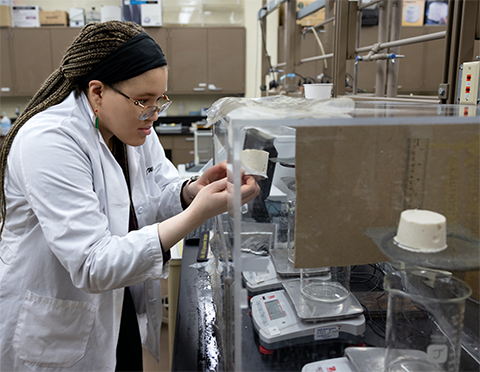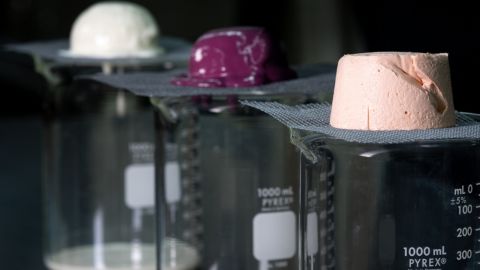
How antioxidant-enhanced ice cream is changing the game for frozen treats
Nothing beats a frozen treat on a scorching summer day — until you face the race to finish before it all melts away. But now biochemists at the University of Wisconsin–Madison are working on creating ice cream that stays in the cone instead of dripping onto your hands — or the sidewalk.
Cameron Wicks is a recent Ph.D. graduate at UW–Madison and soon-to-be food scientist at General Mills. She spent her time in the lab perfecting her “no-melt” ice cream recipe. The secret? Polyphenols.

Polyphenols, also known as tannins, are naturally occurring compounds in fruits and vegetables that boast antioxidant properties and health benefits, such as limiting inflammation. However, Wicks had a different purpose for these molecules in mind.
She was inspired by a Japanese no-melt strawberry popsicle that went viral. “Someone even took a hair dryer to it just to see what would happen,” Wicks said in a Milwaukee Journal Sentinel article.
At UW–Madison, she applied the same principles used in the Japanese popsicle by adding polyphenols to cream and found that some of these molecules slowed its melting rate.
Brad Bolling, an associate professor of food science and Wicks’ mentor, provided his expertise in creating sustainable foods to the project. “This is another ingredient we can add to our food science toolkit,” he said.
However, finding the right ingredients and concentration of polyphenols required much optimization since polyphenols are a large family of molecules that include flavonoids, phenolic acids, lignans and more.
By performing melting tests, Wicks narrowed down these molecules and landed on tannic acid as the polyphenol with the greatest “no-melt” effect on the ice cream.

When she examined the ice cream supplemented with tannic acid closely using a microscope, Wicks found that tannic acid links up with the water, fat and protein molecules to create a lattice network. This rigid lattice holds the water molecules in place, she explained, and doesn’t allow them to accumulate and create the drips you often see on your cone.
“It’s more of a no-drip ice cream,” Wicks said. “The fat aggregates caused by the polyphenols are the reason why the system is able to hold water and the matrix for extended periods of time. … We believe polyphenols change the viscosity in comparison to a regular ice cream.”
On top of minimizing drippage, adding polyphenols slowed the ice crystal growth that usually occurs when ice cream thaws and refreezes. This means polyphenol additives could help eliminate freezer burn and improve the shelf life of ice cream during distribution.
“Ice cream doesn’t actually freeze all the way in your freezer,” Wicks said. “There’s a concentrated serum phase that contains water. With regular ice cream in stores, the transportation system to get it there and getting it home causes a lot of temperature abuse and freeze–thaw cycles. The matrix of polyphenols, proteins and fats makes it a lot harder for that water to be able to flow and grow to create large ice crystals.”
Commercial ice cream contains stabilizers, such as guar and cellulose gums, that are designed to combat freezer burn. However, Wicks said, replacing these with polyphenols, such as blueberry powder, could eliminate ingredients that consumers are not familiar with and supplement the health benefits of sweet treats.
“In our typical diets, we are not getting enough fruits, vegetables and whole grains, which are the major sources of polyphenols,” Bolling said. “So, if we can create a meal that includes polyphenols in the appetizer, main course and dessert, why not look for those applications? … This research project demonstrates the feasibility of that.”
Future work at UW–Madison will focus on optimizing the taste and texture of ice cream that contains polyphenols. In addition, Wicks said she looks forward to introducing polyphenols into dairy-free ice creams, which have a faster melting rate than cream-based treats due to their high water content.
“When you think about nondairy ice creams, there are a lot of challenges to overcome when creating a system that delivers a similar experience to its dairy counterpart,” Wicks said. “I'm definitely excited to see how this research might be able to help make nondairy ice cream better quality and more palatable.”
Enjoy reading ASBMB Today?
Become a member to receive the print edition four times a year and the digital edition monthly.
Learn moreGet the latest from ASBMB Today
Enter your email address, and we’ll send you a weekly email with recent articles, interviews and more.
Latest in Science
Science highlights or most popular articles

The science of staying strong
Muscles power every movement, but they also tell the story of aging itself. Scientists are uncovering how strength fades, why some species resist it and what lifestyle and molecular clues could help preserve muscle health for life.

Bacteriophage protein could make queso fresco safer
Researchers characterized the structure and function of PlyP100, a bacteriophage protein that shows promise as a food-safe antimicrobial for preventing Listeria monocytogenes growth in fresh cheeses.

Building the blueprint to block HIV
Wesley Sundquist will present his work on the HIV capsid and revolutionary drug, Lenacapavir, at the ASBMB Annual Meeting, March 7–10, in Maryland.

Gut microbes hijack cancer pathway in high-fat diets
Researchers at the Feinstein Institutes for Medical Research found that a high-fat diet increases ammonia-producing bacteria in the gut microbiome of mice, which in turn disrupts TGF-β signaling and promotes colorectal cancer.

Mapping fentanyl’s cellular footprint
Using a new imaging method, researchers at State University of New York at Buffalo traced fentanyl’s effects inside brain immune cells, revealing how the drug alters lipid droplets, pointing to new paths for addiction diagnostics.

Designing life’s building blocks with AI
Tanja Kortemme, a professor at the University of California, San Francisco, will discuss her research using computational biology to engineer proteins at the 2026 ASBMB Annual Meeting.

